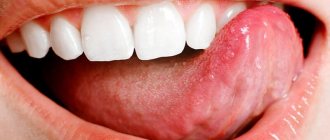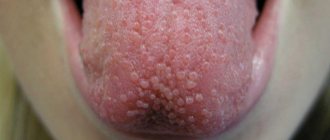A folded tongue is a congenital pathology characterized by abnormalities in the shape and size of the tongue. In approximately half of the cases, this pathology manifests itself together with desquamative glossitis. The folded tongue is also called “scrotal”. This pathology is one of the most common symptoms of Melkersson-Rosenthal syndrome.
What is scrotal tongue
A folded (scrotal or grooved) tongue is a genetically determined disease in which this organ has abnormalities in shape, size and surface structure. This disease usually manifests itself in childhood, sometimes from birth. In a child, the grooves are not as pronounced, but the older a person gets, the deeper and more prominent the folds become. By the way, they may not affect the entire organ, but only some part of it.
Interesting! In Latin, the word “scrotum” means “scrotum”, and the tongue is called scrotal because of the similarity of its surface to the skin folds of the scrotum.
Most often, the organ has one longitudinal groove located between the midline of the tongue and its tip. Transverse grooves lead to it, forming a scrotal system reminiscent of the pattern of a large river basin. On the lower part of the organ you can see symmetrical fringed folds.
In accordance with this, the grooves are of several types: fringed, longitudinal (usually the deepest) and transverse (less deep, directed towards the main longitudinal fold).
Hypothyroidism
This disease is caused by a malfunction of the thyroid gland. The pathology is manifested by swelling of the tongue with characteristic marks of teeth on its surface. Patients are inactive and find it difficult to talk due to dry mouth. There is a sensation of a foreign object in the mouth, the tongue becomes tangled.
External symptoms of the disease include a yellow tint to the skin, swelling of the face, increased hair loss, deterioration of memory and intellectual abilities, disruption of the digestive tract, and disorders of the genitourinary system. Hypothyroidism is treated by an endocrinologist.
Symptoms of scrotal tongue
The grooves can be either an independent phenomenon or a consequence of another disease, however, in both cases, other symptoms may also be observed:
- increase in size and thickness of the tongue (macroglossia). Sometimes the organ becomes so large that it does not fit in the mouth, which is why the person is forced to keep his mouth slightly open,
- difficulty chewing and swallowing (most often with macroglossia),
- the appearance of furrows on the surface (in children they can be almost invisible, but with age they become more pronounced and deep),
- the appearance of a “pattern” on the surface of the organ, consisting of alternating bright red, pink or whitish areas,
- atrophy of the filiform papillae (the back or tip of the organ becomes smooth),
- the sensitivity of the mucous membrane increases, especially after an infectious disease or surgery,
- tingling, tingling, short-term itching,
- enlargement of the submandibular lymph nodes,
- bad breath.
General symptoms of glossitis
The first signs of inflammation of the tongue are discomfort, burning and the sensation of a foreign body in the mouth. Subsequently, the tongue noticeably swells and acquires a burgundy or scarlet hue. The symptomatic picture of the disease may include:
- increased salivation;
- dullness or complete loss of taste;
- perversion of taste;
- pain and difficulty eating;
- slurred speech;
- the patient's desire not to use the tongue when creating sounds.
Symptoms of chronic glossitis
Chronic glossitis is characterized by persistent swelling and changes in the structure of the tissues of the tongue. With bacterial inflammation, hyperemia, soreness, swelling of the affected area and a local increase in temperature can be observed. The development of glossitis, which is of viral origin, is accompanied by the appearance of small blisters on the surface of the tongue, which eventually open and form painful erosions. The disease, which is of a fungal nature, is manifested by the appearance of a dense or loose white coating on the affected surface, as well as hyperplastic changes in tissue.
Reasons for the appearance of folds
Despite the fact that this condition was described by ancient Greek healers, science still cannot say with certainty where this anomaly comes from. Some scientists consider this a hereditary disease, others – a pathology of intrauterine development, and still others – a consequence of bacterial exposure with weakened immunity.
However, most scientists identify several pathologies that can lead to the formation of a scrotal tongue:
- chronic gastrointestinal diseases,
- skin diseases,
- dysfunction of the hematopoietic organs,
- metabolic disorders, endocrine or nervous systems,
- acute infectious diseases,
- radiation or toxic effects on the fetus,
- mental illness,
- connective tissue lesions (collagenosis),
- malnutrition of the tongue mucosa,
- violent reaction of the body to the vaccine (hyperergy),
- acute deficiency of vitamins and microelements (especially during fetal development and in the first months of life),
- functional changes in the body during pregnancy, menstruation, menopause, etc.).
Geographic fold tongue
Depending on various factors of influence, as well as on concomitant diseases, the nature of the grooves can be of several types. For example, desquamative glossitis, which is sometimes called geographic tongue, is characterized by the presence of reddish or gray spots on the surface of the organ. They come in different sizes and are most often separated by yellowish borders of thread-like nipples. Thanks to this pattern, the organ is similar to a geographical map. Often such “cards” indicate the presence of another chronic disease.
Folded tongue with white spots
Sometimes, in addition to the grooves, white spots appear on the organ. Typically, this symptom is observed in several pathologies at once:
- desquamative glossitis,
- Melkersson-Rosenthal syndrome,
- candidiasis glossitis (damage to the mucous membrane of fungal or yeast-like infections, oral thrush),
- leukoplakia (pathological reaction of the mucous membranes to various irritants. Outwardly it looks like a whitish dense spot that can increase in size),
- sclerosing glossitis (begins with tertiary syphilis). The proliferation of connective tissue in this form of syphilis is accompanied by compaction of the organ and a decrease in its mobility, while the scrotal tongue is soft and loose and has good mobility.
Important! Leukoplakia of the tongue is rarely diagnosed; most often the mucous membranes of the inside of the cheeks, palate and angular folds of the mouth are affected. Leukoplakia differs from geographic tongue by compactions in the area of spots (even warty growths) and can develop into malignant formations.
FAQ
How to distinguish leukoplakia from a folded tongue?
Leukoplakia has different symptoms from a grooved tongue. It should be taken into account that some of them may appear if the scrotal disease is not properly cared for.
- Inflammation and swelling of the mouth and tongue;
- Horny formations with a white coating;
- Ulcers and erosions;
- Bleeding of the affected areas;
- The mucous membrane of the mouth and tongue becomes denser and harder;
- Rapid growth of painful formations;
- Proliferation of papillae in affected areas.
Can the tongue bend poorly due to folding?
Most often, the scrotal tongue is soft and mobile. If the bending of this organ is poor, you should consult a specialist. This may be a sign of sclerosing glossitis.
Is it possible to use sea buckthorn if you have a folded tongue?
Yes, you can.
Do they die from this?
No. The main thing is to follow all the points of caring for such a tongue, otherwise other infections may arise, which can lead to very serious consequences.
Is folded tongue a disease?
Yes, this is considered a disease, but it does not threaten the owner with proper care.
How is the disease diagnosed?
First of all, if grooves appear on the tongue or if it increases in size, you should contact your dentist. He will conduct a visual examination of your mouth. At this stage, it is important to identify the type of pathology and exclude (or confirm) diagnoses in which the same phenomena may be observed.
If a concomitant disease is suspected, the dentist refers the patient to the appropriate specialist - rheumatologist, venereologist, neurologist, endocrinologist, etc. – for additional examination.
Folding of the tongue - prerequisites for the development of anomalies and features of care
A folded tongue is a pathological phenomenon in which the organ increases in size and pronounced grooves appear on it. Patients with such diagnoses often do not experience any obvious symptoms, so the problem can often only be detected through a diagnostic examination. However, if you do not take good care of your teeth and oral cavity, the risk of developing yeast fungi greatly increases, which can lead to burning and dryness of the mucous membranes. Later in the article we will talk in detail about what kind of syndrome this is, why deep folds appear on the tongue and how this can be dangerous.
Drug treatment of folded tongue
Since the causes of grooves are not fully understood, and changes in the mucous membrane are irreversible, treatment can only be symptomatic. For example, for fungal infections, antifungal drugs (sodium tetraborate in glycerin, aniline dyes, antifungal ointments based on imidazole) and/or anti-inflammatory drugs (Miramistin, chlorhexidine), as well as immunomodulators and vitamins are prescribed (for example, applications on the tongue with an oil solution of vitamins A and E).
If infectious lesions of the folds develop (food particles may remain in them, which serve as a breeding ground for bacteria), the doctor prescribes antibiotics, antiseptic rinses or mouth baths (for example, 25 drops of a 1% citral solution in half a glass of warm water).
What treatment options are used today?
Since the pathology is irreversible, in most cases it does not require any specific treatment. Sometimes, when the size of an organ reaches critical levels, part of it is excised. If infections are added to the problem, drug therapy and preventive procedures are prescribed.
Medication therapy
If the anomaly has become a prerequisite for the development of a fungal or bacterial infection, as part of the treatment, the specialist will prescribe antifungal and anti-inflammatory drugs, as well as solutions for the antiseptic treatment of affected tissues. Antibiotics and immunomodulators may be prescribed to restore the body's defenses. If a candidiasis infection occurs, a 10% solution of sodium borate in glycerin and Clotrimazole ointment are often prescribed. Antibacterial rinses and applications with anesthetic will help reduce discomfort and relieve pain.
Clotrimazole will help relieve inflammation
“A friend’s daughter had this since birth. But the pathology was diagnosed by the doctor himself; it is almost impossible to notice visually in a small child. As far as I understand from her words, this is not such a terrible anomaly, it’s just that the child has a higher risk of catching a fungal infection. You need to carefully monitor your oral hygiene, but otherwise nothing special. She definitely didn’t have any operations.”
Kim27, Moscow, from correspondence on the forum www.32top.ru
Surgical intervention
Wedge-shaped excision of a part of an organ is an extreme measure, which is used only in rare cases when the tongue significantly increases in size and does not allow normal speaking, chewing food, or even breathing. To avoid dangerous consequences, surgical intervention is used. The procedure is performed by a dentist.
Surgical treatment of pathology
Surgical intervention in the treatment of the above disease is performed extremely rarely and only in severe cases, when the organ becomes so enlarged that it makes eating, breathing and speech difficult. As a rule, surgeons excise part of it in a wedge-shaped manner.
In some cases, if the folds deepen significantly, they can be sutured, including “smoothing” with a laser. Surgical intervention can also be used for chronic inflammation of the furrows - as a preventive measure to prevent severe infectious lesions. In the postoperative period, the patient is recommended to have speech rest, minimize chewing movements and diet therapy.
Structure of the area under the tongue
Everything that is located under the tongue is called the floor of the mouth. This:
- nerve endings;
- hyoid bone;
- hypoglossal muscles;
- salivary gland;
- connecting folds called frenulums;
- vessels.
Each element of the floor of the mouth serves its own purpose and is irreplaceable. Only if all muscles, tissues, glands and nerves are healthy does the tongue function normally. If there is pain under the tongue, then we are talking about pathology.
Disease prevention
In most cases, this pathology does not bother a person, however, for this to continue, the organ must be looked after. Here are some recommendations for preventing inflammation of the scrotal tongue:
- regular oral hygiene. Microparticles of food can get stuck in the furrows (especially if they are deep enough) and rot. This is a favorable microsphere for the development of various bacteria and unpleasant odors,
- irrigating the tongue or rinsing the mouth after eating with special rinses, herbal infusions, baking soda solution,
- careful care of removable dentures and orthodontic structures, as they hinder the natural cleansing of the mucous membrane,
- exclusion from the diet of spicy, salty, too cold or hot dishes, as they are an additional irritant to the papillae on the mucous membrane,
- quitting smoking and alcohol,
- using a special children's toothpaste and a toothbrush with soft synthetic fibers to clean your teeth to avoid injury to the organ,
- Regular (at least once every 6 months) visits to the dentist.
It is important to know! Insufficient care of the scrotal tongue or ignoring foci of inflammation in it is dangerous for the development of severe infectious lesions (catarrhal inflammation, candidal glossitis, phlegmon, abscess, hyperkeratosis) and even cancer.
How dangerous is the phenomenon - what could be the consequences?
If you properly care for your teeth and oral cavity and maintain an acceptable level of hygiene, a folded tongue can cause virtually no trouble, of course, if the size of the organ does not reach critical levels. Therefore, in most cases, careful and regular care for the condition of the organ is sufficient. Neglected hygiene against the background of illness can lead to the addition of fungal infections, the development of catarrhal inflammation, the appearance of abscesses and phlegmons.
The photo shows a fungal infection on the tongue
Also, according to some experts, the presence of an anomaly in a patient increases the risk of developing cancer of the organ. If inflammation has developed, you need to brush your teeth very carefully so as not to touch or injure the affected tissues with the bristles.











